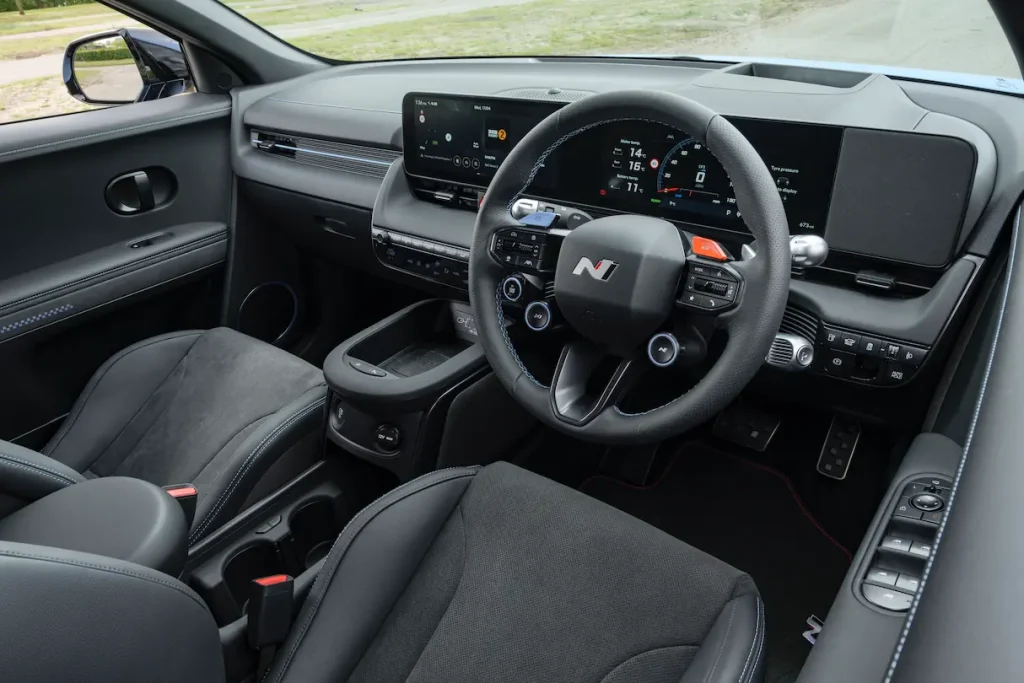
Three years in, and our opinion remains that the Hyundai Ioniq 5 is one of the best EVs on sale and justifiably popular in fleet. However, despite the impressive electric range of all models, plus the spacious and practical interior, like the majority of other EVs, this Hyundai is a tidy, but largely forgettable drive.
That is not something you can say about this version, comprehensively made-over by Hyundai’s high-performance N brand that brought us the excellent i30 N and i20 N.
So, what’s changed over the standard Ioniq 5? Well, a lot. Firstly, the faux Lancia Delta-styled hatchback body is stiffened with 42 extra welds and 2.1 metres of structural adhesive. That is not the end of the stiffening, as the battery, motor mounts, steering mounting, plus front and rear subframes have been upgraded. There’s more power from the twin motors, and bigger brakes – but we’ll talk about that later.
The Ioniq 5 gets the expected sporty makeover with the chunkier N body additions, and 21in alloy wheels that work well on this distinctive large hatch.
Inside, there are new comfortable and supportive one-piece sports seats, a new three-spoke multi-function steering wheel, and sporty pedals.

Despite all the sporty addenda, the interior practicality is not affected, with the same massive rear space. Everything feels well-made, but oddly the dark trim cheapens the feel. Boot space is slightly smaller at 480 litres, although it’s still a good size compared to rivals, even if it’s shallower than expected.
Power boost
Underneath, in addition to the parts that we’ve already mentioned, the front motor generates 223hp, with the rear developing another 378hp, equalling 601hp – or up to the maximum 641hp in 10-second intervals. All of this, and a massive 770Nm of torque. Elsewhere, the Ioniq 5 N gets new axles to deal with this power, plus an electronically limited-slip differential. To make the most of all the performance available, you can choose six driving modes (plus the overboost function), via the four steering wheel-mounted buttons. Two of these modes are customisable, where you can change the weight of the steering, motor response, stiffness of the dampers, the sensitivity of the differential lock and stability control. You can choose to have the fake engine noise on, where the faux gearshift points are, and even change the layout of the head-up display, plus much more.
We’ve mentioned how customisable the Ioniq 5 N’s drive is, and we think living with it would help any owner get the best out of it. We had a mixed 80-mile route and tried it first in ‘Normal’ with the fake engine noise and gears in manual or full auto, then in ‘Sport’ mode with the fake gears in full auto, plus two other pre-configured, more dynamic feeling driving modes.

Compared to the Abarth 500e, the Hyundai’s fake sound is much more convincing – although it droned a bit in ‘Normal’ mode and full auto transmission. The fake gearshift is more impressive – especially with the fake engine noise – they combine to deceive, and the illusion seems to get even better in the custom modes.
With over 600hp, the Ioniq 5 N never feels slow, but unlike most performance EV rivals, Hyundai has really aced the dynamics. The steering is well-weighted and impressively pointy, and the handling amazes, disguising its two-tonne weight. When you need to stop, there’s a likeable, natural feel to the N-tuned brakes. The Ioniq 5 N even feels composed and comfortable at low speeds. Hyundai claims a 278-mile range but use all the performance and we reckon you’ll see closer to 200 – again not bad considering the performance – and it has the same 800V charging architecture.
At almost £65,000, the Ioniq 5 N is not a cheap option, but seems good value compared to premium performance rivals – as this Hyundai drives better than all of them, in our opinion.
Positive: The best EV to drive, amazing performance, same practical and spacious interior.
Negative: Range suffers if you use the performance, 600hp may be too much – it would still be good with half this!
Standard equipment: Part-leather trim, tinted windows, ambient lighting, sliding centre console, two 12.3in dashboard displays, 19in alloy wheels, flush door handles, body-coloured door mirrors, rear-view camera.
Model: Hyundai Ioniq 5 N 478kW
P11D: £64,945
Residual value: 47%
Depreciation: £34,045
Fuel: £4,958
Service, maintenance and repair: £3,524
Cost per mile: 70.87p
Range: 278 miles
CO2 (BIK %): 0g/km (2%)
BIK 20/40% a month: £21/£43
Luggage capacity: 480 litres
Battery size/power: 84kWh/641hp
Score: 9/10





